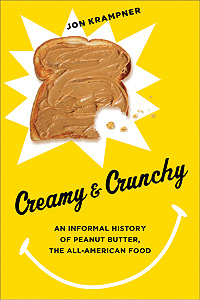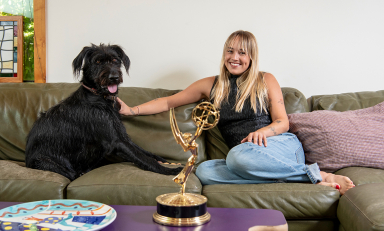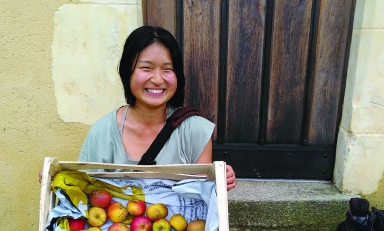Peanut butter is the staff of life for many college students—and biographer Jon Krampner '74 spreads it on thick in a comprehensive history of this all-American food
"My memory may be playing tricks with me," author Jon Krampner '74 begins, "but when I was growing up, I only ate two foods—peanut butter and hamburgers. When I went away to college, my parents said, 'Don't take your portable TV, get out and meet people, and try to eat stuff other than peanut butter.' So I actually went kind of cold turkey. I came out to Los Angeles and discovered Mexican and Filipino and Mongolian food. And throughout the 1970s, I did not eat peanut butter."
Following a string of bad jobs ("I spent the Carter Administration getting fired from small-town newspapers"), the nomadic journalist returned to L.A. in 1980. Around that time, "a romance blew up on me," Krampner says. "I started buying big jars of Skippy and consoling myself in peanut butter—and my weight really shot up." On his nutritionist's advice, he started going to a gym and swore off peanut butter for a second time. "It wasn't until I started working on this book that I got back into it again—purely for research purposes, you understand."
The book in question is Creamy & Crunchy: An Informal History of Peanut Butter, the All-American Food (Columbia University Press; $27.95), published this fall after six years of research, more than 100 interviews, and Lord knows how many jars of peanut butter. Reviews have been largely laudatory—The New Yorker called it "enjoyable and informative"—and so the real question awaiting Krampner is whether peanut butter consumers will nosh on a narrative that seesaws between pop culture (one chapter covers "The Music of Peanut Butter") and arcane process (such as what hydrogenation does to the molecular structure of the vegetable oils used to make peanut butter). "If you write a book about microbreweries or NASCAR or Abraham Lincoln, there are these people who will rush out and buy it," Krampner says at his home in Los Feliz. "I don't know if this will actually be the case, but I was able to convince a publisher."
Having penned two biographies associated with live television dramas of the 1950s—producer Fred Coe and actress Kim Stanley—the native New Yorker was eager to tackle a subject matter closer to comfort food. "I could not do another five- or six-year hitch on a now-obscure tormented genius," says Krampner, who calls himself "a writer by profession, teacher by salary" (he has taught English as a second language at night school since 1988). "I approached this project in a celebratory manner, but as I got into it, my journalistic instincts kicked in."
Whereas the structure of biography is relatively easy—"You have before they were famous, when they were famous, and after they were famous"—a book devoted to peanut butter turned out
to be a stickier proposition. "I worked on this thing for three years before I wrote a word," Krampner admits. After writing a sample chapter to share with the editor on his Stanley biography, he hit upon "this sort of hybrid scheme that's both thematic and chronological."
Krampner devotes a couple of chapters each to the three major brands: Peter Pan (introduced in 1928), Skippy (1933), and perennial market leader Jif (1958). Besides tying Peter Pan's launch to the Roaring '20s, he gets into the origins of hydrogenation, which touches on questions of organic chemistry. But "Science was always my worst subject," Krampner says. "As soon as I got out of high school, I never studied science again."
To aid his own understanding of the process, he contacted the chemistry department at Oxy, where a secretary steered him to professor Chris Craney. "We had lunch in front of the Cooler to explain the difference between flexible and inflexible bonds in hydrogenated and unhydrogenated vegetable oil," says Krampner, who majored in English and comparative literary studies at Oxy. "Chris kind of waltzed me around the patio in front of the Cooler to make the point."
The peanut butter industry was a tougher nut to crack. "The big three were of almost no help whatsoever," Krampner says. "As the head marketing person for Jif said, 'Brand management is our thing. So if we can't control something, we don't cooperate with it.'" The trade groups proved to be a bit more helpful. Sitting down for an interview with the head of the American Peanut Council in Arlington, Va., "I thought he would just wax poetic about peanuts and how important they are," Krampner recalls. "And he said, 'Peanut butter is basically just ground-up peanuts.'"
Other things he learned along the way:
Peanut butter was first produced commercially in the Midwest in the 1890s by George Bayle, a snack food maker in St. Louis. Others insist that John Harvey Kellogg of Corn Flakes fame came first. "They had a sanitarium up in Battle Creek, Mich., and they would grind up peanuts and serve it as a health food. But they boiled their peanuts—they didn't roast them—so the flavor is really different. "To me, George Bayle is probably No. 1, but to peanut butter enthusiasts, it's a subject of some controversy."
There are as many ways to eat peanut butter as there are people who eat it. Krampner eats it two ways: straight out the jar, and in a "sandwich of my own devising, which I call the Simon and Garfunkel. Basically, I put peanut butter of any kind on a whole wheat bagel, add a slice of mozzarella, sauté some mushrooms and spinach in olive oil, grind some pepper over them, put on a slice of tomato, grind up a garlic clove and put that in, and then put parsley, sage, rosemary, and thyme on it. Hence the name. Finally, I squeeze a little slice of lemon over it."
If you eat peanut butter straight out of the jar, be careful. "Believe it or don't, people have actually choked on peanut butter," Krampner says. "I actually did a brief interview with Henry Heimlich, and he said when you eat peanut butter you should do it on bread, because by itself it can just get stuck in your throat. And then, even with the Heimlich maneuver, you won't get it out. When I eat it out of the jar, I eat it a little bit at a time, swirl it around my tongue before it goes down, and I keep some water nearby."
Peanut butter fanatics are hard to come by. In two of the best-known books on food culture—John McPhee's Oranges (1967) and Steve Almond's Candy Freak (2004)—"you come across the most astonishing characters," Krampner says. "In peanut butter there must be people like that, too. But if there are, I failed to locate them. So if they read this, please contact me." (And copy us as well.)




